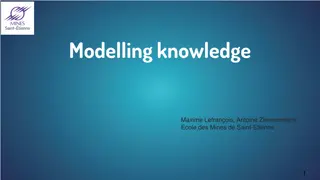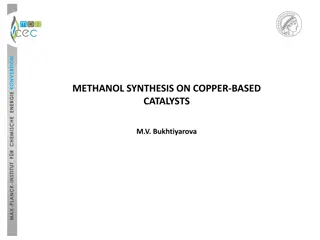Piezotronic Effect Modelling of ZnO Nanowires Under Arbitrary Loading
Explore the multi-physics modelling of the piezotronic effect in ZnO nanowires under arbitrary loading. The research team led by Dr. M. El Hachemi presents innovative designs of micro-strain sensors and piezotronic cantilever sensors, with applications in fields like robotic manipulation and spectroscopy. The fundamentals of the piezotronic model in COMSOL are discussed, including pressure-dependent band-edge shifts and relative volume variations across ZnO layers. COMSOL simulations provide insights into stress and piezo-potential distributions.
Download Presentation

Please find below an Image/Link to download the presentation.
The content on the website is provided AS IS for your information and personal use only. It may not be sold, licensed, or shared on other websites without obtaining consent from the author.If you encounter any issues during the download, it is possible that the publisher has removed the file from their server.
You are allowed to download the files provided on this website for personal or commercial use, subject to the condition that they are used lawfully. All files are the property of their respective owners.
The content on the website is provided AS IS for your information and personal use only. It may not be sold, licensed, or shared on other websites without obtaining consent from the author.
E N D
Presentation Transcript
MEMS DEVICES Multi-physics Modelling of Piezotronic Effect of ZnO Nanowires Under Arbitrary Loading Presenter: Dr. M. El Hachemi Research Team : Dr J. Polesel, Dr. S. Girot, Mr. R. Joly, Mr N. Adjeroud, Mr K. Menguelti Mr. P. Grysan and Mr. S. Klein
MULTIPHYSICS MODELLING Design of micro-strain sensor with gauge factors above 150 Cross-section of one electrode s comb-arm Details of controlled growth of ZnO crystals Details of strain sensor with comb electrodes; The equivalent circuit is parallel Schottky MSM junctions. Typical applications includes: Robotic manipulation of small soft objects Spectroscopy and surface mapping Colloidal force spectroscopy
MULTIPHYSICS MODELLING 2D Model of piezotronic cantilever sensor SchottkyComb 1.2mm 75 m 1 m Cantilever Polymide SU8:Negative tone photoresists (Micro resist EpoCore) [1.42mm,0.6 m] Circuit Board FR4 ZnO[1.2mm,300nm] Pt contacts[10 m,100nm] ?????0 ??0 ?2 Piezochargeszone=5 Cantilever Polymide
MULTIPHYSICS MODELLING Fundamentals of the Piezotronic Model in COMSOL The basic governing systems of equations are: ?.? = ???? ? = ?? ? = ?? + ???? Electrostatic equations(es): ? = ??:??? ??? ???=1 2 ????= ?.??? ???+ ?? + ????? Solid mechanics equations(solid): Semiconductor equations(semi): ? = ????+ ? ? ? + ?? ? ??= ???= 0 ,? ??= +???= 0 ??= ???????+ ??????? + ????,? ?ln ? ??= ??????? ??????? ????,? ?ln ? ??= ? + ????+ ??,??? ???= ?0 ???,??? ?? ????+ ??? ++ ?? ,?. ??? = ? Piezo-electric Solver: dof : 1 098 440 RAM 7GB CPU: 20min -1min/iter ??= ? + ????+ ??,0+ ??,??? Semiconductor Solver: dof : 1 290 773 RAM 17GB CPU: 24h- 4.5min/iter
MULTIPHYSICS MODELLING Pressure-dependant band-edge shift of ZnO ? ???? ???? ???? = 6.05 0.15?? = 2.13 0.15?? = 3.92 0.15?? ? ? Schematic of Piezoelectric n-doped ZnO with Pt Scottky contacts showing charges distribution and energy band diagram variation due to mechanical loading
MULTIPHYSICS MODELLING Relative volume variation across the ZnO Relative volume variation along the ZnO layer due mechanical bending of the cantilever
MULTIPHYSICS MODELLING COMSOL Simulations Animation showing contours of stress and piezo-potential around one Pt contact due mechanical bending of the cantilever
MULTIPHYSICS MODELLING COMSOL Simulations Animation showing contours of electron concentration in the depletion region And electric potential around one Pt contact
MULTIPHYSICS MODELLING COMSOL Simulations Charge densities and piezoelectric potential for each of the Pt contacts
MULTIPHYSICS MODELLING COMSOL Simulations I-V characteristic of the piezotronic sensor
Thanks for your attention We acknowledge the Luxembourg National Research Fund for the FNR CORE grant C16/MS/11349047/PSSENS.























